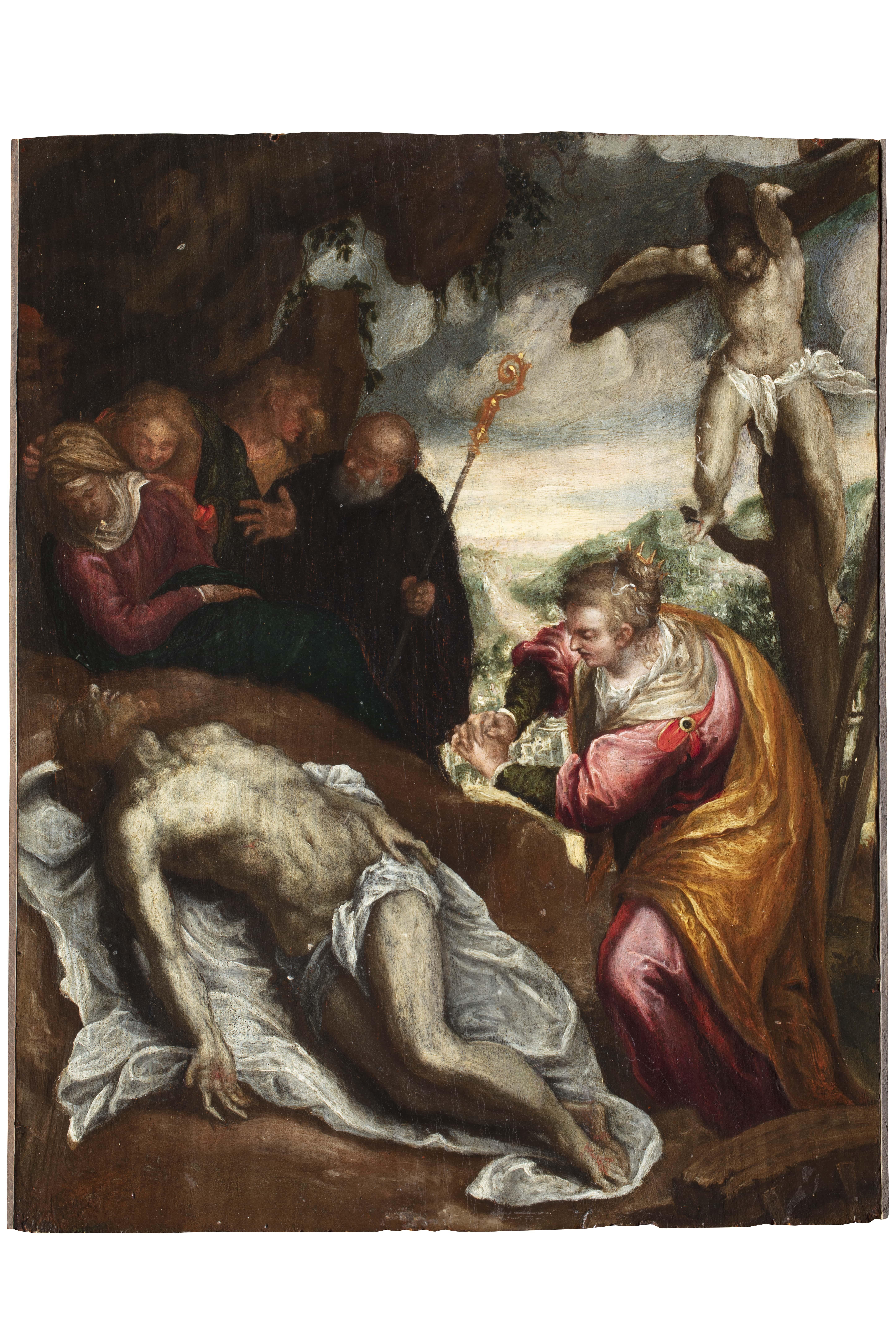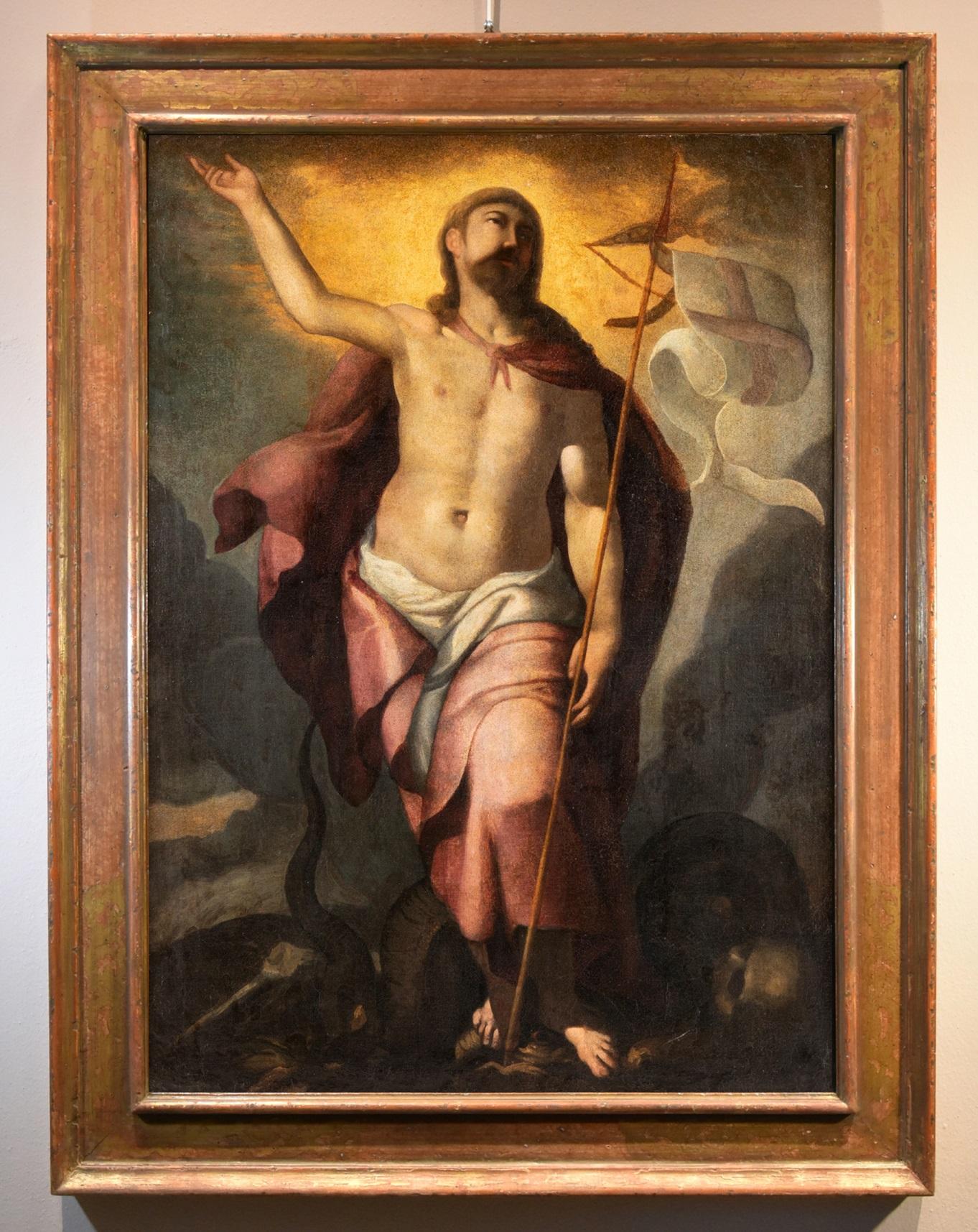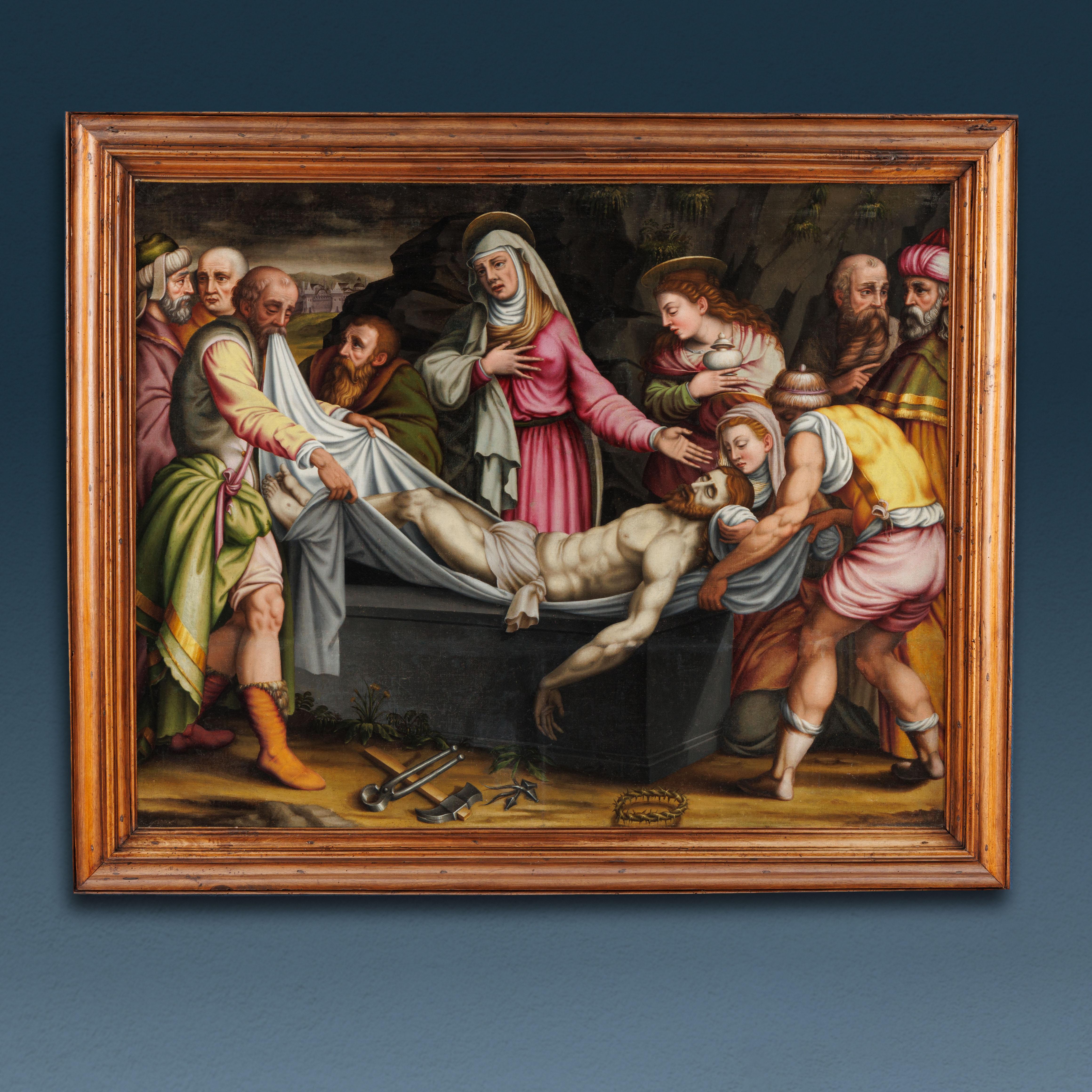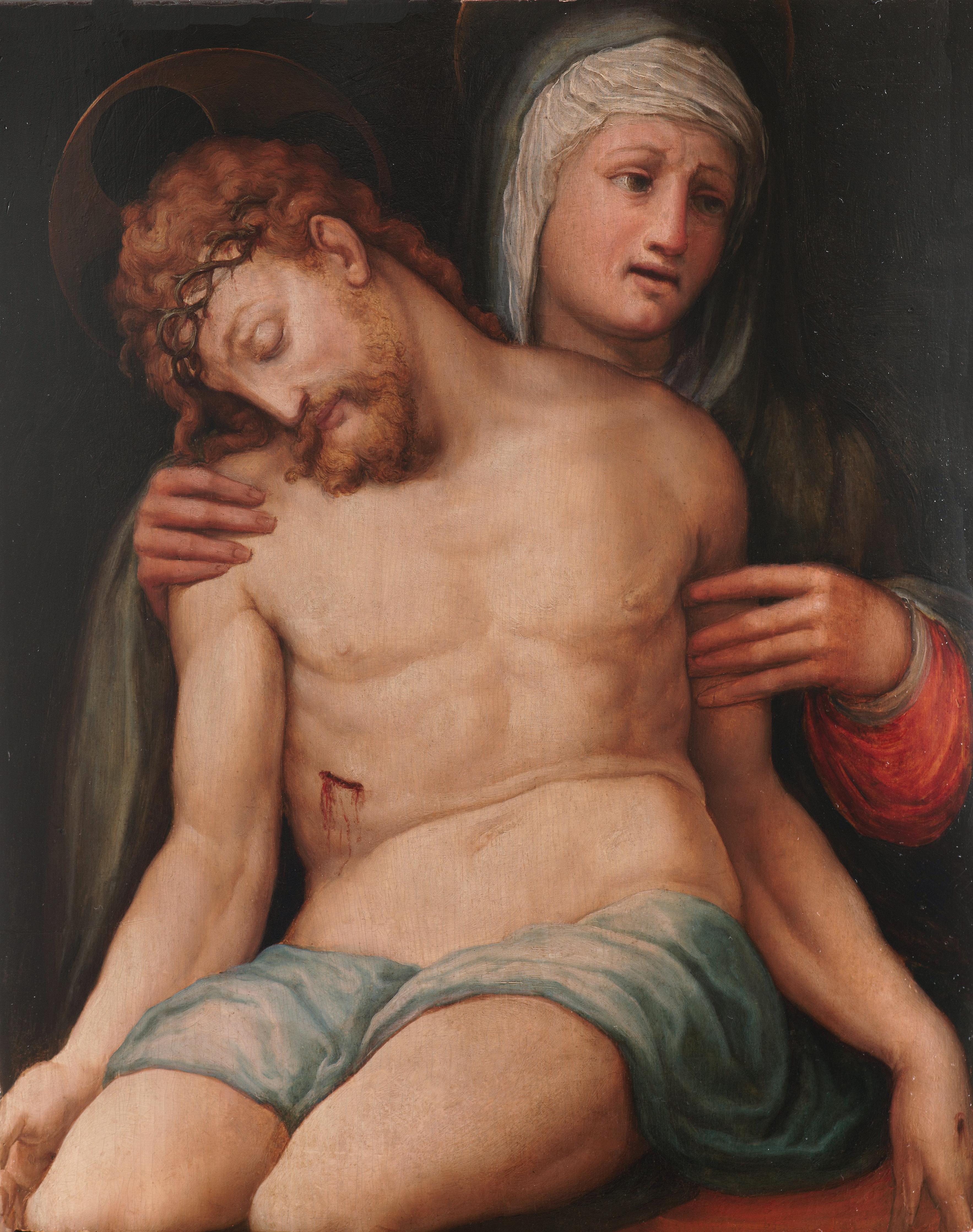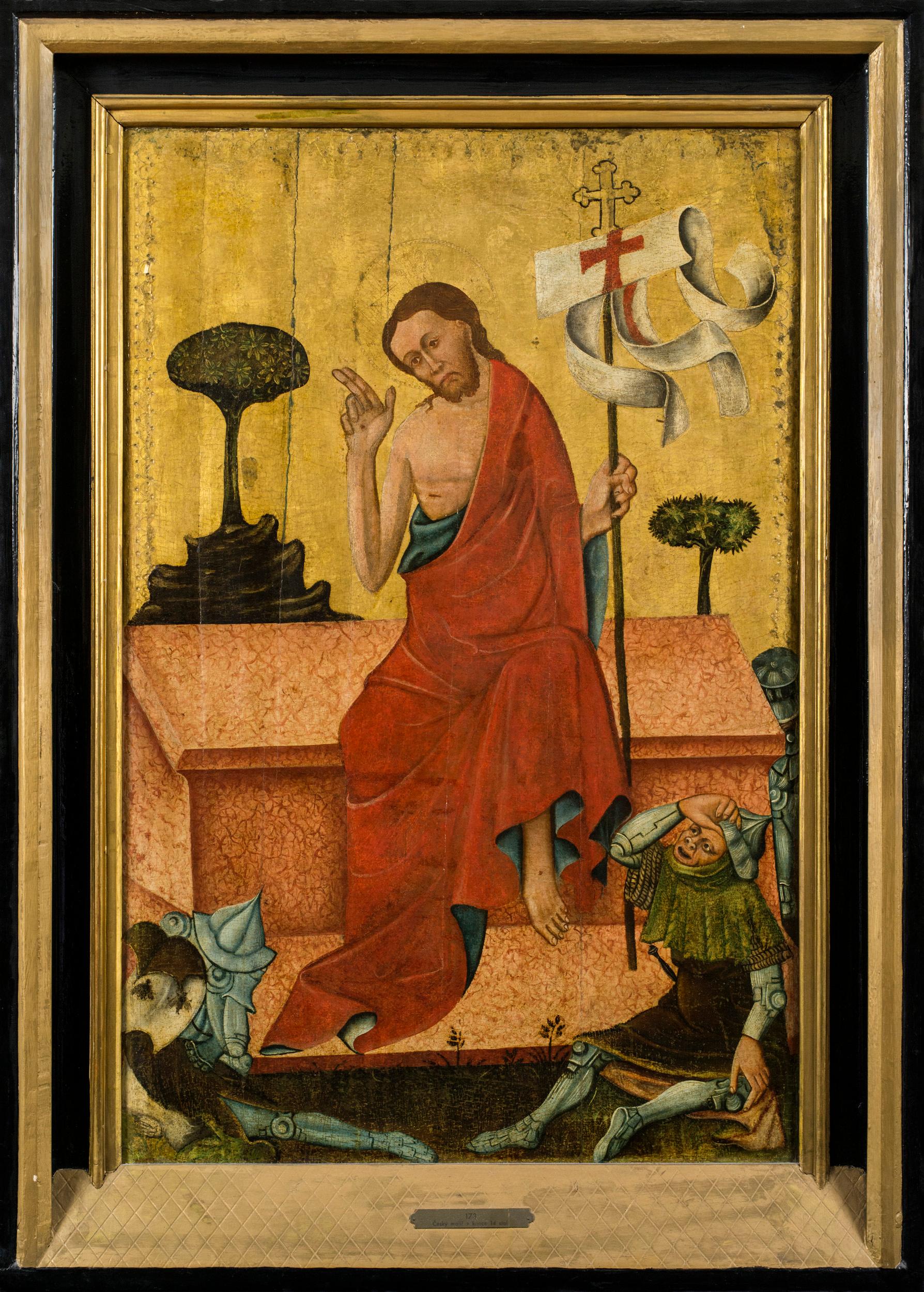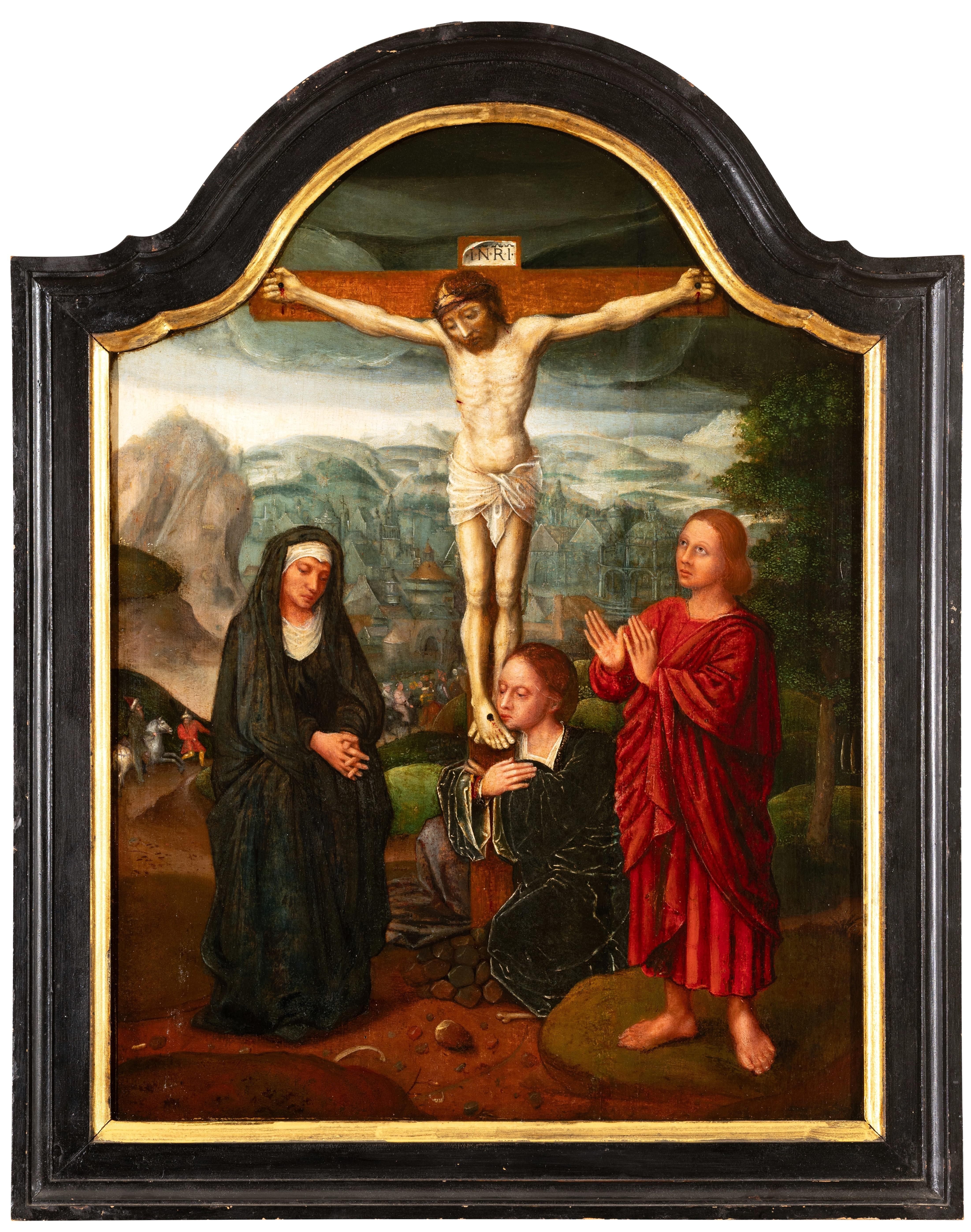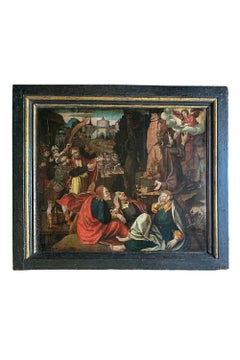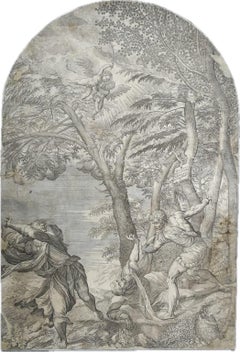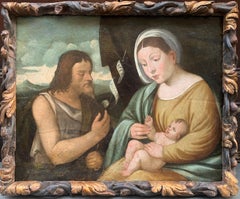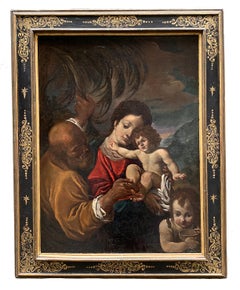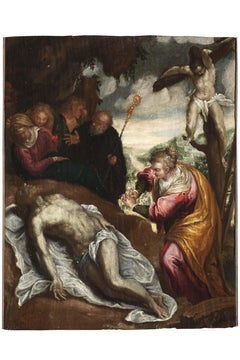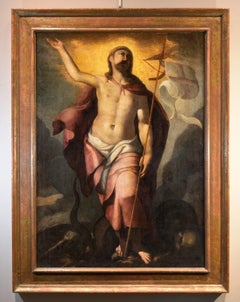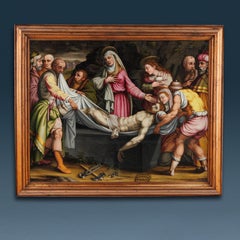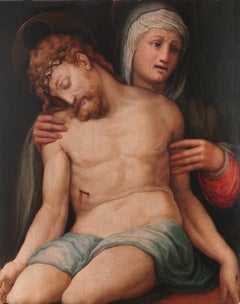Items Similar to Resurrection of Christ. Study of the Master of the Prodigal Son. Ca. 1550.
Video Loading
Want more images or videos?
Request additional images or videos from the seller
1 of 25
UnknownResurrection of Christ. Study of the Master of the Prodigal Son. Ca. 1550.ca. 1550
ca. 1550
$8,995.57
$11,00021% Off
£6,635.62
£8,276.4821% Off
€7,515.92
€9,561.9521% Off
CA$12,463.81
CA$15,545.8721% Off
A$13,533.27
A$16,879.7921% Off
CHF 7,166.86
CHF 8,939.0921% Off
MX$165,879.16
MX$206,897.9221% Off
NOK 88,692.70
NOK 110,624.7121% Off
SEK 83,809.90
SEK 104,534.5021% Off
DKK 57,217.66
DKK 71,366.4921% Off
About the Item
Resurrection of Christ
Attributed to the Master of the Prodigal Son / Jan Mandyn (1500-1560)
Oil on panel, 73 x 56 cm (without frame), 81 x 63 cm (with frame)
The work was examined by Professor Peter van den Brink, who confirmed its connection to the circle of the Master of the Prodigal Son, identified as Jan Mandyn (1500-1560). An artist active in Antwerp, Mandyn was known for his interpretation of Northern Mannerism, characterized by elongated figures, pronounced anatomical details, and a visionary atmosphere. Influenced by the Flemish engraving tradition and the fantastical world of Bosch, he developed a keen interest in narrative detail and imaginary architecture.
His style is part of the Flemish Mannerist school, which flourished in Antwerp and Haarlem in the second half of the 16th century, with artists such as Marten de Vos. His works are distinguished by complex perspectives, theatrical gestures, and vibrant colors.
Professor Peter van den Brink is a recognized specialist in 16th- and 17th-century Flemish and Dutch painting. Former director of the Suermondt-Ludwig Museum in Aachen, he has focused on history painting, portraiture, and collecting practices between the 16th and 19th centuries. He has studied the Antwerp and Haarlem schools and their connections to Italy, specializing in technical analysis, particularly infrared reflectography (IRR). He has curated exhibitions and published numerous studies on Flemish Mannerists.
On the back of the panel, two old printed paper labels indicate an attribution to the Haarlem school, second half of the 16th century, and a connection with the Master of the Prodigal Son.
A preparatory drawing is visible beneath the paint surface, characterized by rigid and angular contours, reminiscent of the Northern graphic tradition. Christ, in ascension, holds a processional cross and a flowing veil. His emphatic gestures and the twisting of the figures enhance the Mannerist monumentality, evoking sculpture and Italian and Flemish bronzetti.
The soldiers, wearing magnificent uniforms inspired by Ancient Rome, reflect the late Florentine and Roman Mannerist style, which was introduced north of the Alps by Northern painters who had worked in Italy.
The landscape, with unreal green hues typical of Flemish painting, features Gothic and fantastical architectural elements. The color contrasts and theatrical composition heighten the supernatural and dreamlike character of the scene.
The iconography follows the traditional model of the "Resurrection of Christ," where the Savior emerges from the tomb enveloped in divine light. The soldiers, taken by surprise, collapse to the ground, while on the right, the Holy Women, witnesses of the scene, approach with fear and devotion.
We offer worldwide insured shipping with professional packing in wooden crate.
- Creation Year:ca. 1550
- Dimensions:Height: 31.89 in (81 cm)Width: 24.81 in (63 cm)
- Medium:
- Movement & Style:
- Period:
- Condition:
- Gallery Location:Firenze, IT
- Reference Number:1stDibs: LU2464215822112
About the Seller
4.9
Vetted Professional Seller
Every seller passes strict standards for authenticity and reliability
Established in 2016
1stDibs seller since 2023
81 sales on 1stDibs
Typical response time: 6 hours
- ShippingRetrieving quote...Shipping from: Firenze, Italy
- Return Policy
Authenticity Guarantee
In the unlikely event there’s an issue with an item’s authenticity, contact us within 1 year for a full refund. DetailsMoney-Back Guarantee
If your item is not as described, is damaged in transit, or does not arrive, contact us within 7 days for a full refund. Details24-Hour Cancellation
You have a 24-hour grace period in which to reconsider your purchase, with no questions asked.Vetted Professional Sellers
Our world-class sellers must adhere to strict standards for service and quality, maintaining the integrity of our listings.Price-Match Guarantee
If you find that a seller listed the same item for a lower price elsewhere, we’ll match it.Trusted Global Delivery
Our best-in-class carrier network provides specialized shipping options worldwide, including custom delivery.More From This Seller
View AllEarly 16th century. The Agony in the Garden. Southern German school.
Located in Firenze, IT
The Agony in the Garden. (Christ on the Mount of Olives).
Technique: Oil on Panel, 4 wooden boards, not parqueted.
Dim. with frame: 78cm x 67cm
Dim. without frame: 52 x 62 cm
Germa...
Category
18th Century and Earlier Northern Renaissance Figurative Paintings
Materials
Oil, Wood, Board
$9,455 Sale Price
34% Off
Renaissance original engraving by Martino. Rota after Titian’s lost altar. XVIc
Located in Firenze, IT
The subject is the Martyrdom of Saint Peter Martyr, after Titian’s lost altarpiece once in the Venetian church of Santi Giovanni e Paolo. The composition shows the violent attack ben...
Category
16th Century Renaissance Landscape Prints
Materials
Paper, Engraving
Venice. XVI century. Madonna with child with St. John. Attrib. Marco Bello.
Located in Firenze, IT
Sacred Conversation: Madonna with child with St. John with idealized landscape background with mountains.
Early XVI century.
Oil on wooden panel of Venetian conifers.
Marco Bello, attributed. (Venezia, 1470 - 1523, Udine), pupil and follower of Giovanni Bellini.
Venetian school.
Madonna with child with St. John with idealized landscape background with mountains.
Dimentions: 57cm x 68cm x 6cm
Beautiful late Renaissance frame...
Category
16th Century Renaissance Figurative Paintings
Materials
Wood Panel, Oil
17th century . Holy Family with the Saint John the Baptist - Bolognese School
Located in Firenze, IT
The Holy Family with the Infant Saint John the Baptist - Bolognese School, 17th century
Attribution: Attributable to Francesco Brizio (Bologna, 1574-1623)
Medium: Oil on canvas
Dimen...
Category
17th Century Italian School Figurative Paintings
Materials
Oil, Canvas
Sadeler Engraving after Maarten de Vos – Saint Michael and the Dragon, 16th C.
Located in Firenze, IT
Saint Michael the Archangel defeating the dragon
Design by Maarten de Vos (Antwerp, 1532 – 1603)
Engraving by Johannes (Iulius) Sadeler I (Brussels, 1550 – Venice?, ca. 1600)
Copp...
Category
17th Century Northern Renaissance Figurative Prints
Materials
Paper, Engraving
17th century Flemish school, Madonna with child and red Drapery. Oil/wood
Located in Firenze, IT
Madonna with Child and Red Drapery, Flemish School, Oil on Oak Panel, 17th Century
Flemish School, 17th century
Technique: oil on oak panel with 4 crossbars
Dimensions: Height: 43...
Category
17th Century Old Masters Figurative Paintings
Materials
Wood, Oil, Wood Panel, Board
$1,723 Sale Price
20% Off
You May Also Like
16th Century by Venetian Maestro Deposition of Christ Oil on Panel
Located in Milano, Lombardia
16th Century Venetian Maestro
Title: Deposition of Christ
Medium: Oil on panel
Dimensions: without frame 40 x 25 cm
Formerly Canesso Collection, Paris.
Fairs: The International Biennial of Antiques in Florence 2022 (BIAF, Biennale Internazionale dell’Antiquariato di Firenze)
Publications: Bozzetti, modelletti, sketches: dalla collezione di Giorgio Baratti (From the Giorgio Baratti Collection) curated by Anna Orlando, Agnese Marengo and Annalisa Scarpa, Genoa, 2022, pp. 22, 23.
In this precious panel we can admire a lament over the body of Christ by a large group of bystanders among whom we can recognise the Virgin and, in the foreground, St Catherine of Alexandria...
Category
16th Century Old Masters Figurative Paintings
Materials
Oil, Wood Panel
Resurrection Christ Tiziano 16/17th Century paint Oil on canvas Old master Italy
By Tiziano Vecellio (Pieve di Cadore 1490 - Venice 1576)
Located in Riva del Garda, IT
The Resurrection of Christ
Follower of Tiziano Vecellio (Pieve di Cadore 1490 - Venice 1576)
Venetian school of the late 16th/early 17th century
Oil on canvas
108 x 78 cm. - Framed 129 x 99 cm.
This jewel of the Venetian school, a work executed between the 16th and 17th centuries by a Venetian artist, illustrates the episode of the Resurrection of Christ: as reported in the Gospel of Matthew (Matthew 28:1-7) the event is accompanied by an explosion of light and glow, with the figure of Christ rising into the sky.
Christ's face, serene and victorious, looks up towards the Light and the Infinite, in contrast to his majestic figure, here constructed with the appearance of a classical sculpture, contrasted by an intensely luminous background.
The Risen One firmly holds in His hand the banner (white with a red cross) of the Resurrection, also known as the flag of St. George, which iconographically represents His victory over death, while raising His right hand in a blessing act. With his feet he crushes a snake and a skull, a sign of Christ's triumph over sin and death.
The painting belongs to the Venetian school and presents clear reminiscences with the works of Titian Vecellio...
Category
17th Century Old Masters Paintings
Materials
Oil
$8,090 Sale Price
20% Off
Deposizione di Cristo nel sepolcro. Pittore lombardo (Giuseppe Meda?) 1560-1570
Located in Milan, IT
Olio su tela. La grande scena racconta la Deposizione di Cristo dalla Croce, condensando due momenti della narrazione: il Compianto della Madonna sul corpo del Cristo e la deposizion...
Category
18th Century and Earlier Other Art Style Figurative Paintings
Materials
Oil
The Lamentation of Christ, 16th Century Oil Old Master
Located in London, GB
Circle of Ridolfo Ghirlandaio
1483 - 1561
Oil on panel
Image size: 20 ½ x 16 ½ inches (52 x 42 cm)
Handmade contemporary style gilt frame
The lamentation of Christ was one of the most popular scenes depicted in European art from the 11th to the 18th century. Depicting the lamentation or pieta from the Italian word for ‘Pity’ of Christ with Jesus’s mother Mary cradling his body.
Christ is depicted nude, wearing only a blueish loincloth around his waist, a horizontal scar marking his rib cage. His head and torso are held upright, and his eyes are closed, his right arm lays to his side as does his left. Standing behind him, is the Virgin Mary, outfitted in her traditional dress of a robe with a white veil. She stands behind Christ and bends slightly, looking looking away from Christ to something that has caught her attention, her right hand holding his shoulder. Her left-hand carefully holds his arm.
This work is quite unusual with Mary . This stunning work jumps out with its dark background and strong flesh colours.
Ridolfo Ghirlandaio was the son of the eminent painter Domenico Ghirlandaio. Following his father’s death in 1494, when he was just eleven years old, Ridolfo is thought to have continued his training with his uncle Davide, who had taken over the Ghirlandaio workshop. Vasari noted that Ridolfo also studied with Fra Bartolommeo...
Category
16th Century Old Masters Figurative Paintings
Materials
Oil
The Resurrection of Christ
Located in New York, NY
Provenance:
with “Mr. Scheer,” Vienna, by July 1918; where acquired by:
Jindřich Waldes, Prague, 1918–1941; thence by descent to:
Private Collection, New York
Literature:
Rudolf Kuchynka, “České obrazy tabulové ve Waldesově obrazárně,” Památky archeologické, vol. 31 (1919), pp. 62-64, fig. 5.
Jaroslav Pešina, “K datování deskových obrazů ve Waldesově obrazárně,” Ročenka Kruhu pro Pěstování Dějin Umění: za rok (1934), pp. 131-137.
Jaroslav Pešina, Pozdně gotické deskové malířství v Čechách, Prague, 1940, pp. 150-151, 220.
Patrik Šimon, Jindřich Waldes: sběratel umění, Prague, 2001, pp. 166, 168, footnote 190.
Ivo Hlobil, “Tři gotické obrazy ze sbírky Jindřicha Waldese,” Umění, vol. 52, no. 4 (2004), p. 369.
Executed sometime in the 1380s or 1390s by a close associate of the Master of the
Třeboň Altarpiece, this impressive panel is a rare work created at the royal court in Prague and a significant re-discovery for the corpus of early Bohemian painting. It has emerged from an American collection, descendants of the celebrated Czech industrialist and collector Jindřich Waldes, who died in Havana fleeing Nazi-occupied Europe.
The distinctive visual tradition of the Bohemian school first began to take shape in the middle of the fourteenth century after Charles IV—King of Bohemia and later Holy Roman Emperor—established Prague as a major artistic center. The influx of foreign artists and the importation of significant works of art from across Europe had a profound influence on the development of a local pictorial style. Early Italian paintings, especially those by Sienese painters and Tommaso da Modena (who worked at Charles IV’s court), had a considerable impact on the first generation of Bohemian painters. Although this influence is still felt in the brilliant gold ground and the delicate tooling of the present work, the author of this painting appears to be responding more to the paintings of his predecessors in Prague than to foreign influences.
This Resurrection of Christ employs a compositional format that was popular throughout the late medieval period but was particularly pervasive in Bohemian painting. Christ is shown sitting atop a pink marble sarcophagus, stepping down onto the ground with one bare foot. He blesses the viewer with his right hand, while in his left he holds a triumphal cross with a fluttering banner, symbolizing his victory over death. Several Roman soldiers doze at the base of the tomb, except for one grotesque figure, who, beginning to wake, shields his eyes from the light and looks on with a face of bewilderment as Christ emerges from his tomb. Christ is wrapped in a striking red robe with a blue interior lining, the colors of which vary subtly in the changing light. He stands out prominently against the gold backdrop, which is interrupted only by the abstractly rendered landscape and trees on either side of him.
The soldiers’ armor is rendered in exacting detail, the cool gray of the metal contrasting with the earth tones of the outer garments. The sleeping soldier set within a jumble of armor with neither face nor hands exposed, is covered with what appears to be a shield emblazoned with two flies on a white field, somewhat resembling a cartouche (Fig. 1). This may be a heraldic device of the altarpiece’s patron or it may signify evil, referencing either the Roman soldiers or death, over both of which Christ triumphs.
This painting formed part of the collection assembled by the Czech industrialist and founder of the Waldes Koh-i-noor Company, Jindřich Waldes, in the early twentieth century. As a collector he is best remembered for establishing the Waldes Museum in Prague to house his collection of buttons (totaling nearly 70,000 items), as well as for being the primary patron of the modernist painter František Kupka. Waldes was also an avid collector of older art, and he approached his collecting activity with the goal of creating an encyclopedic collection of Czech art from the medieval period through to the then-present day. At the conclusion of two decades of collecting, his inventory counted 2331 paintings and drawings, 4764 prints, and 162 sculptures. This collection, which constituted the Waldesova Obrazárna (Waldes Picture Gallery), was first displayed in Waldes’ home in Prague at 44 Americká Street and later at his newly built Villa Marie at 12 Koperníkova Street. This Resurrection of Christ retains its frame from the Waldes Picture Gallery, including its original plaque “173 / Česky malíř z konce 14 stol.” (“Czech painter from the end of the 14th century”) and Waldes’ collection label on the reverse.
The Resurrection of Christ was one of the most significant late medieval panel...
Category
15th Century and Earlier Old Masters Paintings
Materials
Tempera, Panel
Crucifixion, Bruges school, Flemish, mid 16th century
Located in PARIS, FR
Crucifixion, cercle of Adriaen Isenbrandt, mid 16th century
School of Bruges, cercle of Adriaen Isenbrandt (actif 1510-1551)
Oil on oak panel with its original ebonized frame
Dimensi...
Category
16th Century Old Masters Figurative Paintings
Materials
Oak, Oil, Wood Panel
